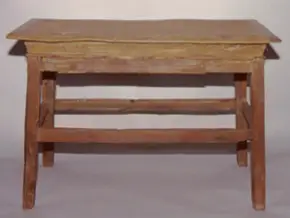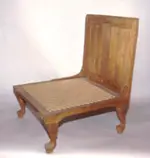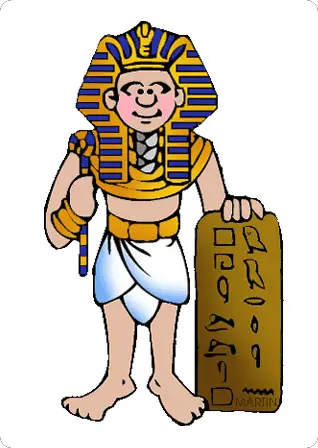Egyptian Furniture
Most people in the world are lucky enough to have land around them that grows trees. These cultures build all kinds of beautiful furniture using the wood from the trees. Egypt is mostly desert and the land that they do have is devoted to growing crops for food. This means that there was very little wood furniture in ancient Egypt, except in the very rich and wealthy households.


Most of the poor people in ancient Egypt had only stools, reed matts, rugs and reed baskets to store items, inside their homes. There were almost no tables and the scribes that did all of the writing usually sat on the floor and wrote on wood planks.
The wealthy households did have wood furniture made mostly from imported wood. Many of the homes had beds, chairs, tables and chests. The somewhat rich did not decorate their furniture, but they very rich spent a lot on artists to paint and inlay their furniture.

Beds usually had comfortable mattresses and the headboards had images of gods to protect them. The legs of some beds were carved to look like animal legs and the bed sloped so that the head was higher than the foot of the bed. The bedframe had strips of cloth or leather to bind and hold it so that the person could sleep on that or a mattress on top. A few beds have survived throughout the years and they were designed as folding beds and even canopy beds.

Tables were almost always low to the floor and were created with one, three or four legs. Archeologists have found some stone tables and a few that were made out of metal. The ancient Egyptians used a lot of stools and these were made with skin and leather coverings; some were even collapsible.

Chairs were designed for the very wealthy and those that have been found have detailed carvings. The chairs were much lower than the chairs that we use today and were usually covered in the seating area with leather or cloth. It seems that the chairs were built based on the social ranking of the individual that was going to sit in it. The higher the rank, the taller the legs on the chair.

Some homes had boxes to contain their more expensive items. These boxes were usually made of wood with inlaid ivory. The construction was very detailed. Beginning with the Middle Kingdom on, boxes have been found that were covered in veneer. Veneer is a type of wood overlay that was costly and required a special craftsman. Some of the boxes even had sliding lids.

Some of the boxes that were larger were like today’s storage chests. These might have held jewelry and were typically only in the wealthy households as well as the royal family homes. These chests were usually held with hinges and might have had pegs glued to keep the lids in place. The very finest included a set of locking strings tied to knobs.
The ancient Egyptians loved to play games and gaming tables were more common in the rich homes. The tables might have had small drawers to keep the various game pieces. Drawers were not commonly used in Egyptian furniture design.

As Egyptians made more furniture, they began to use more animal leg and forepaw styles for the legs of chairs, beds and tables. Bull legs and hooves also became popular and later lion paws were more commonly seen on stool legs.
The use of lamps was a priority for the Egyptian home. Usually these were made of shallow pottery and they had olive oil, castor berry and fat inside. They used a wick to float on the top and when lit it would last as long as the container was in size. Wicks were made of linen and they added salt to keep the lamp from producing a lot of smoke.



